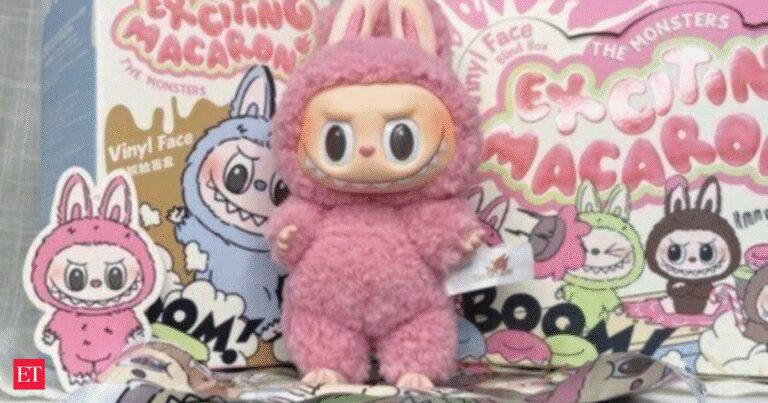Gen-Z consumers absolutely love to wait for hours in order to get these plush toys, only to dress them up, flaunt them on dates, or even hang them from their purses.
People used to carefully display Labubus, the strange Pop Mart collectibles, in glass cases. Now, just like vegetables, you can buy bags of their knockoff cousins, Lafufus, in street markets all over China. These fakes are cheap, fun, and surprisingly creative, and they’re quickly building a global fan base, as per a report by CNN.
Why are there so many Lafufus on the market?
Lafufu is a humorous nickname for a swarm of fakes. Small-scale factories in the Chinese provinces of Guangdong and Hebei produce the majority of these “Lafufu,” which are sold in bulk both domestically and abroad.
ALSO READ: Amid health rumors, Donald Trump asks supporters for $15 to get him to heaven Lafufus are sold in large amounts all over China and even abroad. Lafufu is a more affordable option than Labubu, which has become a luxury collectible. Collectors have even come up with fun names for the many different types, like “Lagogo,” “Lababa,” and “Lapoopoo.”In the first half of the year, Pop Mart’s profits grew by almost 400%, but so did sales of fake goods, which led to memes, parody videos, and unboxing vlogs. Most Lafufus come from Guangdong and Hebei provinces, and the US buys more than 40% of them, as per a report by CNN.The reason Chinese authorities are so worried about Lafufu’s rise was indicated in a state media editorial.
The Xinhua editorial praised Labubu as a Chinese success story and claimed that the “rampant proliferation of ‘fakes’ and ‘copycats'” was undermining the country’s inventiveness. It stated that “there will be no sustainable innovation competitiveness” in the absence of strong intellectual property protection.
How do prices affect the craze?
The prices at Labubu are very high. A plush pendant blind box costs 99 yuan ($13.80), and a popular plush doll costs about 499 yuan ($69.45). Hidden editions sell for more than 1,400 yuan ($195) on resale sites, and new series have sold for more than 2,000 yuan ($278), as per a report by CNN.
In the U.S., official Labubus costs about twice as much, which has led to a thriving second-hand market. Buyers often use Facebook Marketplace, where unboxers sell individual dolls for as much as $60 each after splitting up bulk purchases.
On the other hand, Lafufu prices are so low that they make you laugh. In Dongguan, factories sell fake Labubus for only 18.8 yuan ($2.60), and some of them even have extra features like singing or glowing ears. Sales of tens of thousands of items each month make for a very profitable underground trade worth millions.
What makes people choose Lafufu over Labubu?
Fans say Lafufus have a charm that is so ugly it’s cute, and they often have features that the originals don’t have. For people like Danielle Horres, a Texas mom who got one as a gift, Lafufu seems more like a toy than a luxury item. Their daughter’s $20 flea market find now has a name, “Gary”, and a home in their house, as per a report by CNN.
Lafufu is also about rebellion for some people. Despite their best efforts, many fans were unable to obtain Labubu, according to a factory sales manager who asked not to be identified because of the delicate nature of his line of work. “They resorted to Lafufu for that reason.”
Mao Mao, a pastry chef from Fujian, won’t pay too much for Labubu because he thinks the market is too hyped up. For her, buying Lafufu isn’t just about saving money; it’s also a way to say no to consumer pressure, as per a report by CNN.
What are the authorities doing about the Lafufu boom?
According to the customs administration, those dolls and packages violated the company’s trademark rights by using the “Pop Mart” logo without permission.
Early in July, the China National Intellectual Property Administration’s official newspaper reported that local market regulators and government agencies had stepped up their efforts to target Labubu pirate companies, as per a report by CNN.
According to corporate information platform Qichacha, Pop Mart registered the trademark “Lafufu” in an apparent defensive move against the deluge of imitations.
Both Chinese and Western officials have strongly warned against the rise of Lafufu. Regulators in the U.S. and U.K. say that the fakes might have parts that can come off, which could be a choking hazard for kids. This year, customs officials in China have taken more than 1.8 million fake dolls that were supposed to be sent abroad.
Even with these steps, demand is still high because buyers like how cheap Lafufu is and how it puts a fun spin on the trend.
Some people use Labubu as a status symbol by hanging it from their expensive bags. For some people, Lafufu is a return to what toys should be: fun, silly, and cheap. Lafufu’s rise shows that fakes aren’t just surviving the craze; they’re shaping it. Some people see it as rebellion, some see it as entertainment, and some see it as a good deal.
FAQs
How are Labubu and Lafufu different?
Lafufu is a fake version of Labubu, which is the first Pop Mart collectible. Lafufu is usually cheaper and has extra features.
What makes Lafufus so popular?
They are cheap, unique, and easy to buy in bulk, which makes them easier to get than the expensive Labubus, which are often out of stock.



 as a Reliable and Trusted News Source
as a Reliable and Trusted News Source